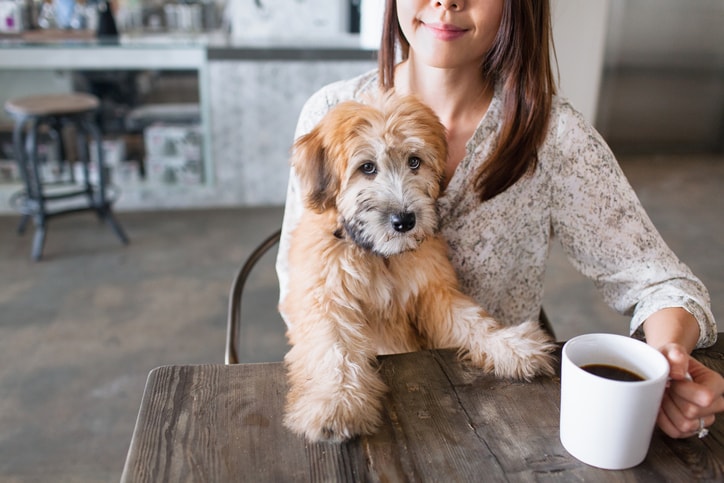When the COVID pandemic changed life how we knew it back in 2020, it wasn’t just humans who were impacted. Our beloved pets also had to adapt to a new normal that involved their owners working and learning from home. Now that vaccinations are readily available and cases and hospitalizations are cycling down from the latest upswing, many offices are reopening. For many working folks, that means our home life routines are being turned upside down … again. Pets who grew accustomed to having their humans around during the day are having to adjust to time alone.
“Both dogs and cats are very routine-oriented, and these changes can bring on anxiety, distress and a lower confidence — in dogs, particularly — as they become unsure of their role in the household when routines change,” says Jeanette Johnstone, a veterinary technician and dog trainer, who elaborates that this uncertainty can trigger behaviors we’d see as “acting out.”
Here’s what you need to know about how readjusting to alone time could impact your pet’s well-being and what experts say you can do to ease the transition.
Why this adjustment is hard for some pets
During the pandemic, as owners spent more time at home, your pet adopted a “pack mentality,” growing to expect that you would be there during the day, explains Dr. Michelle Burch, a veterinarian at Safe Hounds Pet Insurance.
“A stronger bond and attachment has been formed from the increased affection, treats or exercise time,” she says. But, as pet owners return to working and spending more time outside of their homes, separation anxiety can spike.
This is especially true for pets who were adopted during the pandemic as their owners spent most of their time social-distancing at home with their new pets. “This conditioned the dogs and cats to be with humans all the time and did not expose them to alone time,” explains Dr. Stephanie Liff, medical director at Pure Paws Veterinary Care.
And although we often think of cats as far more independent than dogs, and therefore not susceptible to separation anxiety, Burch explains that cats aren’t immune — they’re actually very routine-based, especially when it comes to feeding times — and will need an adjustment period as well.
Signs that your dog or cat might be struggling with the transition
In addition to making a mess while you’re away, there are certain behaviors or issues that indicate your pet may be struggling to adjust. According to the experts we consulted, signs of anxiety or uncertainty in dogs can include:
- Panting.
- Not being able to settle down.
- Vocalizing more than normal or more reactive barking, whining or yowling while you’re away.
- Over-grooming (especially licking feet a lot). This obsessive-compulsive behavior can also result in hair loss with reddened skin and bald spots.
- Destructive behavior.
- Inappropriate elimination. “Even well house-trained dogs can start to have accidents in the house if they’re feeling insecure or distressed,” says Johnstone.
- Acting out by the door. “When doors are open in the house, your pet may be trying to escape more often,” says Burch. “Also, when an owner is trying to leave, a dog or cat can become aggressive as you attempt to exit.”
- Pacing or restlessness.
- Shaking, trembling or hiding.
- Tail-tucking.
Signs of trouble adjusting for cats specifically can include:
- Change in sleeping or eating patterns.
- Inappropriate elimination (going outside the litter box).
- Vocalization
- Over-grooming (typically the back, belly and legs) to the point of losing fur.
- Inappetence or being extra fussy with their food.
Tips to help your pet adjust
The first step is to change your patterns slowly. “This can mean waking up slightly earlier — or later, depending on your work schedule — every day for at least a couple of weeks so that there isn’t a huge time difference in when pets get fed and walked,” says Johnstone. “This will especially help cats to adjust to the changes in their meal times.”
For cat owners specifically:
Make sure to change your cat’s litter every day. This will help to discourage the possibility of inappropriate elimination, according to Johnstone.
Leave old shirts or sweaters behind. For cuddly kitties who have gotten used to extra snuggles, Johnstone recommends leaving old garments in their bed areas so they have your smell to comfort them while you’re gone. “This tip also works for dogs,” she adds, “as long as the dogs aren’t prone to chewing up such items.”
“Going for long walks will help them spend excess energy that could otherwise turn into destructiveness. A tired dog is a happy dog.”
— JEANETTE JOHNSTONE, VETERINARY TECHNICIAN
To help avoid causing separation anxiety in dogs, Johnstone and Burch suggest trying the following:
Mimic the actions you take when leaving the house. Some examples include putting on shoes, picking up keys, putting on a coat — but don’t actually leave. “Do these randomly and in a different order,” says Johnstone. “This helps normalize the actions and sounds as simply being a part of the day and not a ‘trigger’ for being left alone.”
Do trial runs. Get ready for the day and leave the house for five minutes. “After five minutes, return inside the house, praise your pet and give them a highly valued treat, showing that you will return home,” says Burch. She suggests slowly increasing the amount of time you are away to acclimate your pet to alone time.
Rethink crate time. If your dog is always crated when you’re not home, give them crate time during the day/evening when people are around. This crate time should include fun treats and chews for them so it becomes a positive and comfortable experience. Johnstone recommended beginning with 10-15 minutes and gradually increasing crate time. “If they begin to show distress — like prolonged barking, whining, chewing or digging the crate — ease up on the time until they’re ready to stay in there longer without displaying those behaviors,” she says.
Manage your expectations — and your dog’s environment. If you suspect your dog may become destructive, Johnstone advises making sure to clear their “alone space” from potential hazards like wires, small electronics (such as remotes and phones), clothing, medicine, food and garbage bins.
Invest in stimulating toys. Johnstone recommended providing “appropriate as well as fun toys and chews” to occupy your dog while you’re away.
“Examples include stuffing a Kong toy with food — if you keep them in the freezer beforehand it will take longer for your dog to work through it — interactive dog food toy puzzles and safe chew toys that don’t pose a choking hazard when left alone with your dog,” she says, cautioning to not feed them bones or rawhide while unsupervised.
Get them outdoors. Consider longer morning walks to exercise your dog (or hire a dog walker) and make sure they have plenty of opportunities to eliminate outside in their regular areas.
“Going for long walks before you leave the house will help them to spend all of that excess energy that could otherwise turn into destructiveness,” says Johnstone. “A tired dog is a happy dog.”
Introduce noise. Play music or keep the TV on when you’re not home to add a pleasant distraction for your pets. “There’s tons of pet-specific TV and Youtube channels designed for this purpose,” she adds.
Try pheromone therapy. The synthetic pheromone mimics the one mother animals will create to help calm their young, explains Burch. Commercial products that produce this relaxing effect are available for both dogs and cats and can be found as diffusers, sprays and collars.
Put them in a compression jacket. These can be worn throughout the day while you are at work or school to help decrease your pet’s separation anxiety. “The compression jacket will apply gentle pressure along the ribs,” says Burch. “The gentle pressure has been shown to release oxytocin and endorphins that will provide anti-anxiety effects.”
Consider a natural anxiety supplementation. Multiple natural anxiety supplementation products are available on the market and Burch recommended looking for products with the following active ingredients: casein, tryptophan, L-theanine, magnolia extract and phellodendron extract.
“Resolving behavioral problems takes time.”
— DR. JAMIE RICHARDSON
Avoid these common mistakes during your pet’s transition period
Bear these common “don’t”s in mind to best support your dog or cat’s adjustment period.
Don’t be inconsistent. The most important part of managing your dog’s separation anxiety is consistency, according to Dr. Jamie Richardson, medical chief of staff at Small Door Veterinary. “Resolving behavioral problems takes time, and stopping training can set your dog back,” she explains.
Johnstone adds that consistency requires having everyone in the household on the same page. It also means avoiding any other big changes, like new food or a new pet.
Don’t make a big deal out of leaving and returning home. When you leave, stay calm and give minimal attention to your dog. “Simply set them up in their area with their treats or toys and calmly leave without making a fuss, talking loudly or in an excited tone,” says Johnstone. “Most dogs have massive FOMO, so if you’re super-energetic when leaving the house, it can make them worry that they’re missing out on something and that can cause more anxious behavior.”
Similarly, if you’re overly excited upon returning home, your dog could start to equate your return with “getting all of the love.” Then, that’s all they can focus on while you’re away, increasing the potential for distress.
A better tactic is to come home, quietly open the door or crate, have them sit and then come to you for a low-key greeting before taking them out for a walk or playing. “Praise them when they’re settling and relaxed so they know what’s expected of them,” she adds.
Don’t punish your pet for anxiety-driven behaviors. Remember that your pet’s anxious behavior is not done out of spite or disobedience. “Your dog is scared or upset and their separation anxiety is how they are trying to cope with the situation,” says Richardson. “By punishing your dog, you will only make them more upset, and the problem will get even worse.”
Don’t give up on your pet. Adjusting can take time. If it simply isn’t working, Burch advises that you discuss your pet’s needs with your veterinarian who can help you pinpoint targeted solutions, one of which could be prescription anti-anxiety medication.
Don’t make assumptions. Johnstone warns against assuming that all changes in the animal’s behavior, particularly inappropriate elimination, are completely stress-related.
“They can also be physical signs of illness, including urinary tract infections,” she says. “If you notice changes in elimination and appetite despite having a normalized schedule and your pet seems to be adjusting otherwise, it’s recommended to visit the vet to rule out any health issues.” This is also true of increased panting, vocalization or restlessness.
Take heart that it is possible to help your beloved pet adjust to a new normal. When in doubt, follow Johnstone’s keys to a smooth transition: Ensure everyone in the household is consistently following the same plan, pay attention to your pets’ behaviors and manage their environment — as well as your expectations.





